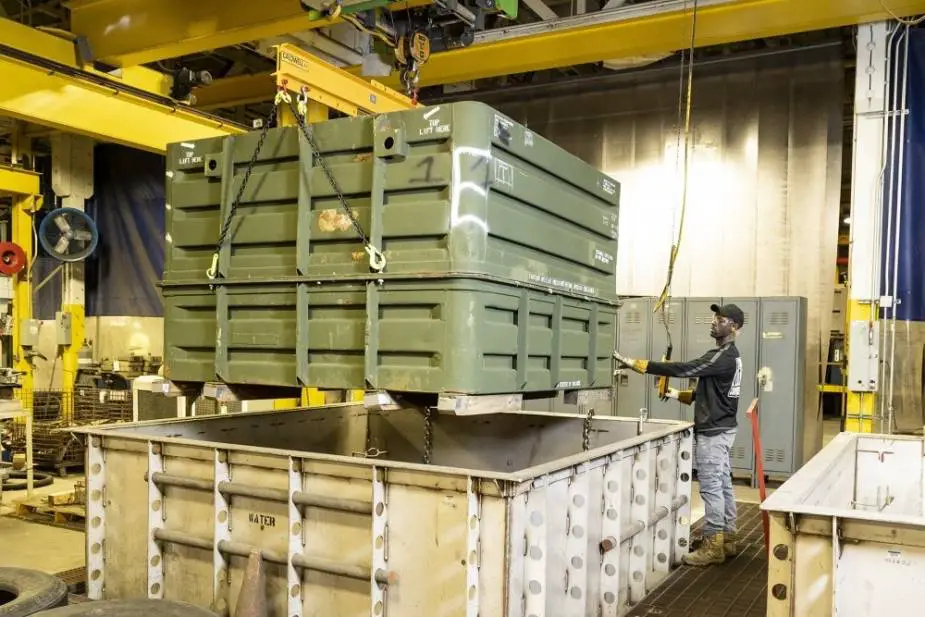New US strategy paves way for industrial base modernization
Persistent modernization of the U.S. Army’s Organic Industrial Base alongside the weapon systems, ammunition and platforms the facilities support must begin now, said Army Materiel Command’s top leader. Kim Hanson reports on U.S. Army's website.
Follow Army Recognition on Google News at this link

Welder Leondric Johnson uses the 3-ton crane to lower the 1790 engine metal shipping and storage container into the test vat for pressure testing at Anniston Army Depot, Ala. Gen. Ed Daly, commander of the Army Materiel Command, said modernization plans must be accelerated at the Army’s depots, arsenals and ammunition plants, most of which were built during World War II. (Picture source: U.S. Army/Mark Cleghorn)
During a guidance session on March 25 on a new OIB modernization strategy, Gen. Ed Daly challenged the leaders of his Life Cycle Management Commands and 26 depots, arsenals and ammunition plants to think and plan big. “We are at an inflection point and we must accelerate our modernization plans for the next 15 years,” said Daly. “We all know the Army Senior Leader priorities of people, readiness and modernization. I firmly believe this effort affects all three.”
The Army OIB, comprised mostly of facilities that were built during World War II, manufactures, upgrades, maintains and resets Army equipment. While some of the sites have seen incremental modernization over the years, this is the first comprehensive approach in recent decades, said Daly.
With a steady focus on Aim Point 2035, Daly and AMC Deputy Chief of Staff for Logistics, G-4, Juanita Christensen laid out the framework of the modernization strategy. The end state is a comprehensive OIB investment plan that sustains the artisan workforce, maintains pace with the Army’s modernization of weapon systems, and enables surge capacity for large-scale combat operations. “We need to understand the true requirements for modernization with an unconstrained approach,” said Christensen. “We are using the same tactics and process as we did for the Facilities Investment Plan – capture all requirements holistically and then prioritize.”
The 15-year OIB modernization strategy uses a four-phase approach to identify, evaluate, analyze and develop a plan to incorporate emerging technologies into the OIB. LCMC and OIB commanders will ultimately assess and execute the inclusion of new, 21st-century technology that can improve conditions, efficiencies and effectiveness across facilities.
Although not limited to these technologies, the strategy specifically calls out the use of advanced sensors, robotics, computer programming logic in machining, plant and process layout, and remote operating capabilities. “I want you to think, in 15 years when I walk this ground, what is it going to look like and will it be prepared to support multi-domain operations in large-scale combat operations,” said Daly.
Coordination with Army Futures Command, their Cross-Functional Teams and the Program Executive Offices responsible for developing the next generation of Army equipment is a critical component of the strategy, Daly said. “I hold OIB commanders accountable for making sure you are supporting modernization efforts and thinking forward on what equipment and weapon systems will need to be manufactured, maintained and upgraded in your facilities,” he said. “We cannot modernize the OIB without a firm understanding of the systems the OIB is intended to support.”
AMC is working contract mechanisms to allow OIB commanders to leverage industry expertise through the process, said Christensen. “We must capture industry standards and best practices in these assessments, and optimize LMP [Logistics Modernization Program] and data analytics,” she said.
Daly also charged commanders to consider climate change and energy efficiencies, as well as physical and cybersecurity and protections. “You all have area development plans, but those have accounted for funding constraints. We were constraining ourselves, because of constrained resources,” Daly said. “Don’t start with a constrained budget; start with what will make us a 21st century Army that can withstand surge capabilities.”
The one thing that will remain constant is the focus on providing a quality work environment for the OIB workforce, Daly said. “Life, health and safety must still be your number one priority,” he said.
LCMC and OIB commanders will provide regular progress reports to AMC leadership through multiple forums including the tri-annual updates with major subordinate commands and the bi-annual OIB Summits. “If we don’t do this now, we set ourselves back for 21st-century warfare,” Daly said. “This is about how we get ready for the next war; it’s about our ability to surge quickly to match the speed of competition, crisis and conflict. We can’t afford to wait any longer to modernize. There are always going to be budget constraints. We need to ensure our plans are solid, understand requirements, and then we can go after the funding.”
With an Execute Order to be published by April 30, Daly said the 15-year modernization plan gives LCMC and OIB commanders great latitude to consider what depots, arsenals and ammunition plants should look like without limits. “We have the opportunity now for wholesale change,” he said. “This will be command-centric and staff enabled, and one of the most significant things we do in the next two to three years. Plan for success, plan to be resourced. Give it your best approach, effort and military advice.”


























